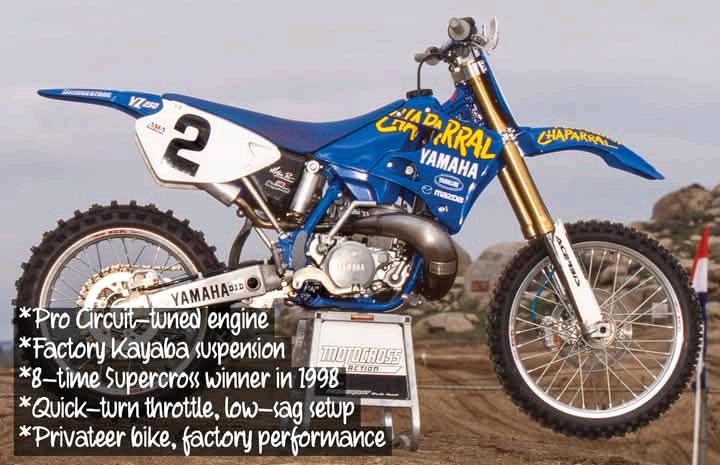Jeremy McGrath left Honda and shocked the motocross world by switching to the Chaparral Yamaha privateer team in 1998, and still won 8 Supercross races on this YZ250….
Jeremy McGrath’s Stunning 1998 Season: Leaving Honda and Dominating on the Chaparral Yamaha YZ250
In the world of motocross and Supercross, few names command the kind of respect and awe that Jeremy McGrath does. Known as “The King of Supercross,” McGrath rewrote the rulebook on how to win and dominate in the stadiums of America during the 1990s. But perhaps no moment in his illustrious career was more shocking—or more revealing of his raw talent—than his dramatic departure from the factory Honda team at the end of 1996 and his subsequent rise to dominance aboard a *privateer* Yamaha YZ250 in 1998.
This wasn’t just a switch of bikes or logos—it was a seismic shift that sent tremors throughout the motocross industry.
The Breakup: McGrath Leaves Honda
After clinching four consecutive AMA Supercross titles from 1993 to 1996 with Honda, McGrath was on top of the motocross world. Riding the iconic CR250R, he was more than just a champion—he was *the* face of Supercross, and his partnership with Team Honda looked bulletproof. But when Honda’s corporate structure and development path began to conflict with McGrath’s vision, tensions rose. In particular, Honda was pushing to develop their new aluminum-framed CR250 for 1997, and McGrath was not impressed with the early versions of the bike.
Rather than being forced to ride a machine he didn’t believe in, McGrath made a stunning decision—he walked away.
Initially, he signed with Suzuki in 1997, but it was an awkward and less successful year. He won only two races that season and finished second in the championship, a letdown by his lofty standards. Many questioned if McGrath’s era of dominance was ending.
Enter the Privateer Era: Chaparral Yamaha and the YZ250
In 1998, Jeremy McGrath shocked the world again by signing with **Chaparral Motorsports**, a privateer team run by Dave Damron, and riding a Yamaha YZ250—*not* the factory version, but a slightly modified production bike. While Yamaha gave technical support, McGrath was not riding under the official factory umbrella. At the time, this was nearly unheard of for a multi-time champion. No one expected him to return to top form, much less dominate.
But McGrath was on a mission. He surrounded himself with a trusted inner circle, including his legendary mechanic Skip Norfolk and trainer Gary Semics. With their help, he customized the Chaparral YZ250 to suit his riding style—nimble, smooth, and with razor-sharp throttle control.
1998 Supercross Season: 8 Wins, One Statement
What followed was one of the most impressive seasons in Supercross history. Jeremy McGrath didn’t just win races—he *owned* them. He claimed **eight Supercross victories** in the 1998 season, a staggering feat for any rider, let alone one not backed by a full-factory team.
His wins came with dominance and finesse. The YZ250, though lacking the factory trickery and bottomless budget of Honda or Kawasaki’s efforts, was more than capable in McGrath’s hands. His superior corner speed, otherworldly timing on rhythm sections, and calm confidence made him the most feared man on the gate.
Despite a mechanical DNF at the season opener in Los Angeles and a few off-podium nights, McGrath pushed the championship down to the wire. Ultimately, he finished **second overall** in the standings behind Jeff Emig, but not before sending a loud and clear message to the world: Jeremy McGrath didn’t need a factory team to be the best.
Legacy of the 1998 Season
The impact of McGrath’s 1998 season can’t be overstated. It changed how the motocross industry viewed privateer teams. Until then, the assumption had been that without factory backing, you couldn’t win. McGrath crushed that notion.
He redefined what was possible with the right team, setup, and mindset—even outside the rigid structure of a corporate program. His success forced manufacturers to rethink their strategies and opened the door for more hybrid team models, where top riders could get factory-level support in more flexible environments.
Even more, it solidified McGrath’s place as the sport’s ultimate showman and competitor. While some riders are great because of their equipment, McGrath proved his greatness transcended machinery.
The YZ250: A Legend Cemented
McGrath’s 1998 Yamaha YZ250 became legendary in its own right. With its blue plastics, white number plates, and minimalist graphics, it symbolized rebellion against the norm. The bike wasn’t exotic, but it was *effective*, and in McGrath’s hands, it looked like an extension of his body.
To this day, that Chaparral YZ250 is one of the most iconic bikes in Supercross history—not because of innovation, but because of what McGrath achieved on it. It’s a reminder that talent, will, and experience often matter more than sheer horsepower or sponsorship dollars.
—
Conclusion: The King Does It His Way
Jeremy McGrath’s move to Chaparral Yamaha in 1998 is one of the boldest, most fascinating decisions in motocross history. It wasn’t just a team change—it was a bet on himself. And he won.
That season, McGrath proved something to fans, critics, and perhaps even to himself: greatness isn’t dependent on the logo on your bike. It’s about heart, preparation, and execution. In a world where factory backing often spells success, Jeremy McGrath reminded everyone that *kings make their own rules*.
And in 1998, the King of Supercross ruled again—on a privateer bike that became a legend.
